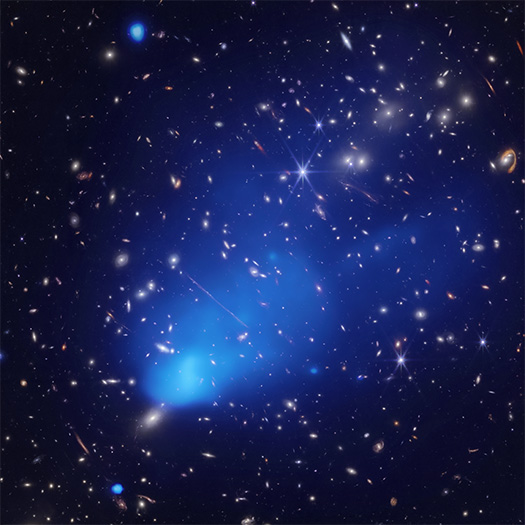"El Gordo": A Galaxy Cluster That Pushes the Limits

El Gordo
Credit: X-ray: NASA/CXC/Rutgers/J. Hughes et al.; Infrared: NASA/ESA/CSA, J.M. Diego (IFCA),
B.Frye (Univ. of Arizona), P.Kamieneski, T.Carleton & R.Windhorst (ASU);
When astronomers discovered the galaxy cluster ACT-CL J0102-4915 in 2012 with NASA's Chandra X-ray Observatory and ground-based optical telescopes, they nicknamed it "El Gordo" (Spanish for the "Fat One") because of its gigantic mass. Scientists estimate that El Gordo contains as much as 3 million billion (3,000,000,000,000,000) times the mass of the Sun. Thanks to its heft, El Gordo acts as a natural lens, distorting the light from more distant objects behind it through a process known as gravitational lensing.
A new composite image of El Gordo shows the diffuse, superheated gas in the cluster observed in X-rays from Chandra (blue) that have been combined with a new infrared image from NASA's James Webb Space Telescope (red, green, and blue). Webb's image shows galaxies in El Gordo plus background galaxies located further away from Earth. El Gordo is located about 7.3 billion light-years from Earth and the background galaxies are at a range of different distances including several that are 12.3 billion light-years from Earth. The appearance of some of the background galaxies has been distorted into a variety of unusual and highly elongated shapes because of gravitational lensing by the cluster.
The X-ray image of El Gordo reveals a distinct cometary appearance. Along with optical data, astronomers reported in 2012 that this shape implies El Gordo is, in fact, the site of two galaxy clusters that ran into one another at several million miles per hour. The same study also used Chandra and other observatories to show that El Gordo is the most massive, and produces the most X-rays, of any known galaxy cluster at its distance or beyond.
Four new papers discussing the Webb observations have recently been accepted, including two that discuss Chandra data. Newer Chandra observations obtained after the 2012 study increase the exposure time by a factor of six, providing much more detailed information about the density and temperature of the cluster’s hot gas. Those Chandra-inclusive papers are led by Brenda Frye (University of Arizona) and Jose Diego (Instituto de Fisica de Cantabria, Spain). All four papers are part of the JWST “Prime Extragalactic Areas for Reionization and Lensing Science” (PEARLS) project led by Rogier Windhorst of Arizona State University. Highlights of the results from the papers are described in a press release from Space Telescope Science Institute.
NASA's Marshall Space Flight Center manages the Chandra program. The Smithsonian Astrophysical Observatory's Chandra X-ray Center controls science operations from Cambridge, Massachusetts, and flight operations from Burlington, Massachusetts.
